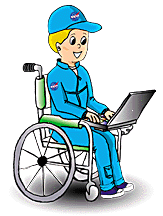![]()
 |
Guess what?The word astronaut means "star sailor" in Latin. |
| Every two years, NASA must make the difficult decision of selecting new members of the astronaut corps. From thousands of applications that are sent in from all over the world, NASA selects approximately 100 people to go to the Johnson Space Center in Houston, Texas for a week of interviews, medical examinations, and orientation. The 100 astronaut candidates are interviewed by the Astronaut Selection Board. The board is looking for people who have experience and potential, people who are motivated and have the ability to work as part of a team, and people who can communicate well. Applicants must be adaptable and understand the tremendous workload that is involved in becoming an astronaut. Many candidates withdraw their application after they realize the time and danger involved in being an astronaut. |
|
While in college, future applicants should concentrate their studies in the technology, math, and science fields. An applicant should also make the effort to gain additional experience by interning in a related field. If the applicant's goal is to be a pilot/commander in the astronaut program, they must have logged at least 1000 hours of flight time in command of a jet aircraft before the selection board will consider them. The selection board sends a list of the final candidates to the NASA Administrator. The Administrator makes the decision of who will actually join the program. Every two years, approximately twenty people are chosen to fill vacancies in the astronaut corps. Astronauts are usually eligible for a flight assignment one year after completion of basic training.
|
ASTRONAUT TRAININGTraining is held at Johnson Space Center in Houston, Texas. The novice astronauts are trained in aircraft safety which includes ejection, parachute, and survival instruction. Mission specialists and pilots are trained in a T-38 jet in order for them to gain experience in a high-performance aircraft. A Gulfstream II aircraft, which has been modified to simulate the handling of a Shuttle, is also used to train pilot astronauts. The astronauts are given a range of basic science, math, and technology courses. The astronauts receive training in a mock-up of the Space Shuttle. Each astronaut must also learn to function in weightless environments, and possibly even learn to perform a space walk. Advanced training follows the basic training program. The advanced training program consists of sixteen different courses covering all Shuttle-related crew training requirements. The advanced training continues even after a crew has been given a flight assignment. Starting at about ten weeks before a mission, the astronaut team starts to simulate the mission with the Earth-bound flight control team who will assist them in their flight. |
|
PilotThe Shuttle pilot is second in command. The pilot's primary responsibility is to control and operate the Shuttle. Pilots assist the Shuttle commander as necessary. Shuttle pilots must be United States citizens. |
Mission SpecialistMission specialists are responsible for coordinating all on-board operations. Mission specialists perform on-board experiments, space walks, and handle the payload. Mission specialists must be United States citizens. |
|
|
Payload SpecialistPayload specialists are professionals from the physical or life sciences field, or they are highly skilled technicians who can operate the Shuttle payload equipment. Payload specialists are chosen by the payload sponsor or customer. Training for a payload specialist may begin as much as two years ahead of the scheduled flight, depending on the task the specialist must perform. |
A QuestionIf you dream of one day flying the Space Shuttle, what can you do today to prepare yourself for application to the astronaut program? |
| Did you know? |
The Answer |
![]()
| Show me the Level 1 version of this page. |
The StarChild site is a service of the High Energy Astrophysics Science Archive Research Center (HEASARC), within the Astrophysics Science Division (ASD) at NASA/ GSFC.
StarChild Authors: The StarChild Team
StarChild Graphics & Music: Acknowledgments
StarChild Project Leader: Dr. Laura A.
Whitlock
Curator:
Responsible NASA Official: